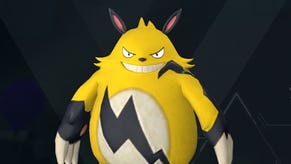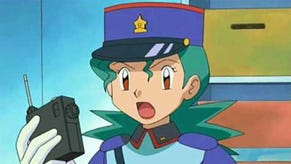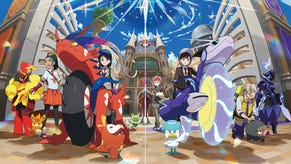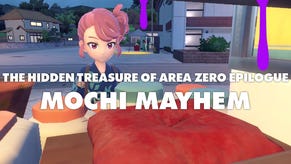Pok¨Śmon Scarlet and Violet are comprehensive technical failures
Embarrassing artwork, terrible draw distance, poor performance and a litany of bugs.
Recent Pokémon games haven't really been known for their technical sophistication. Newer titles have oscillated between simple isometric 3D games and more ambitious, open efforts, but none have particularly impressed. Pokémon Scarlet and Violet, however, seem to be qualitatively different. Almost every review mentions major technical issues, and players have documented countless areas of concern - from poor image quality and frame-rates to fundamental problems like game-breaking bugs. Our own analysis is damning: the new Pokémon release has problems across the board - and it's actually in comparisons to Pokémon Legends: Arceus that we begin to see just how much of a backward step this is.
Cutting to the chase, Pokémon Scarlet and Violet simply do not live up to the standards of other Pokémon titles. There are so many glaring technical problems that it's going to be difficult to cover them all, but the most fundamental issue is the poor visual design and asset quality. Scarlet and Violet are bland and extremely basic-looking: environmental assets are of a low quality with basic geometry, ugly tiled textures and simple designs. At a distance, the environmental assets look at their worst, stripped of most detail and completely lacking shadows. Violet makes use of some pretty harsh normal maps to add detail here, clasing with the game's generally otherwise low-frequency aesthetic.
Textures in general are pretty bad, both in terms of artwork and asset quality. Low resolution 2D art is everywhere, while texture art used for larger surfaces is usually very crudely tiled, with obvious and unsightly repeated patterns. Even before you consider any of the game's serious technical faults and cutbacks, the fundamental artwork often looks ugly and cheap.
There are also issues with draw distance and LOD management. To start with, NPCs and Pokémon pop-in suddenly at relatively close distances, and often jump in and out of existence as you approach. It's a highly distracting issue, particularly when traveling at speed. Making matters worse, the game doesn't keep track of Pokémon entities at all after they pop out, so moving forwards and backwards effectively despawns whatever Pokémon that were present. Environmental geometry and shadow maps also pop in quite close to the camera, which is jarring. There's zero approximation of shadows at range, except for some ugly texture-based cloud shadows, so shadow draw can be very conspicuous here. Certain environments also have sudden lighting changes when you pass a certain threshold.
That's not all. At just about any distance from the player at all, animated objects will start to run at reduced rate animation, presumably to lower CPU load. I noticed reduced animation rates anywhere between 1/4 rate to 1/15th rate in my gameplay. In the video, you'll see what I mean, where I use a windmill as a glaring example - at a close distance it updates at 30fps, then 7.5fps, then 3fps, then 2fps as we get further and further away. This is most noticeable on NPCs in the game's town areas, which run at very low animation rates until you are within a few metres. Reduced-rate animation is a perfectly fine optimization to ease CPU demands, but it's rarely used at anything like this sort of range.
I have plenty more visual grievances. Pokémon battles take place on the world map but don't look very good, with awkward camera animation and poor asset quality. It's pretty easy to get the camera to clip through geometry in general gameplay, even without trying to. Visual glitches like flashes of culled geometry are a frequent sight, especially when traversing back and forth through environments. And this early-game physics challenge just looks sort of ridiculous, with floaty physics that have zero impact on the player character.

So is there anything about Pokémon Violet that works? Some of the smaller-scale environments can be reasonably attractive, with good-looking baked lighting and decently detailed assets. These spaces are pretty constrained and are usually presented from fixed camera angles, but they are definitely the visual highlight of this game. Character designs can be quite attractive and unique, particularly for NPCs important to the main story, and the Pokémon themselves mostly look fine as well.
Beyond that, there aren't many positive things I can say. And that unfortunately extends to image quality and performance. In docked mode, the game runs between 720p and 1080p, typically hovering around 864p during gameplay. Portable mode has a resolution range of 576p to 720p, though it typically stays at or near 720p outside of towns. In practice, image quality is questionable in docked mode. The combination of long lines of sight with zero anti-aliasing and limited post-processing makes pixel crawl very obvious. Portable play fares somewhat better here but it's not especially clean, particularly when the resolution dips.
Pokémon Violet targets 30fps, but suffers from near-constant frame-rate dips and stutters. Frame-rates between 25 and 30fps are common during traversal, with occasional frame-time spikes to 100ms and above. It's a pretty unpleasant experience in general. Portable mode fares about the same as docked, with similar frame-rate drops and momentary hitches. At worst, Pokémon Violet can run at 20fps for extended periods, like in certain demanding cutscene sequences and when traveling through some of the game's towns. On the whole, it's a very unstable-feeling title. Pokémon battles fare somewhat better than traversal, but you will spend a lot of time moving through the open world which presents an unsteady and rough experience.
And that's not for a lack of optimisation, as a lot of effort seems to have been made to claw back every possible margin of performance here. From the aggressive draw distances, to the brutally cut-down animation rates, to the extensive use of dynamic resolution, Violet is pared-back about as far as you can go - and still can't manage to hold on to 30fps. Plus, when the game drops frames you can feel animation slow down, suggesting that game speed is tied to frame-rate. Given those cutbacks I suspect Pokémon Violet is significantly CPU-limited in general play, which would also make sense given the dramatic frame-time spikes we often see.
Recently, in Bayonetta 3 coverage, we put forward the idea that the game was just too demanding for the Switch hardware - but the same cannot be said for Pokémon Scarlet and Violet. Stacked up against Breath of the Wild or Xenoblade Chronicles 3, it's clear that Switch is capable of delivering good-looking, expansive open worlds with decent image quality and fairly solid performance. However, it's the comparisons against Pokémon Legends: Arceus that prove to be the most devastating - remarkable really, bearing in mind that it's the same developer with many of the same team members producing both games.
At the time of its release, Arceus wasn't exactly a top-flight visual experience, but it looks much better than Pokémon Scarlet and Violet. The terrain in Arceus is pretty nicely sculpted, with realistic-looking rock formations and reasonably high-quality texturework. Most of the terrain features in Violet look laughably simple, by comparison, with some of the most blatant texture tiling I've seen in a modern game, and the geometry is simple and crudely rounded. Even effects like cloud shadows are downgraded in the transition from Arceus to Scarlet/Violet.
Environmental assets in general look much better in Arceus. It's hard to draw up one-to-one comparisons, but I think the buildings in Arceus look much more visually pleasing, particularly at a distance. Basic texture assets are also higher-quality in Arceus, like the grass textures, which are quite crude in Violet. Arceus suffered from some pop-in issues, but Violet is dramatically worse. NPCs draw much further afield from the player in Arceus, and fade in over several frames. Shadows draw in at a much greater distance in Arceus as well. Critically, distant NPCs and animated objects run at good animation rates in the older game - but not in Scarlet/Violet.
There are plenty of basic visual deficits in Violet too. Rendering resolution has been cut back relative to Arceus, which typically ran at 1080p in docked mode and ran at a locked 720p when on the go. Shadows look seriously degraded as well, particularly in Pokémon battles. On top of all of this, I do think Arceus's visual style looks more coherent. Arceus maintains a style clearly inspired by Breath of the Wild, with the same painterly blend of cel-shaded characters and low-contrast, stylized environmental artwork. Violet sort of mashes different visual elements together - smooth Pokémon and untextured grass are juxtaposed against crude environmental geometry with stark normal maps. Even absent the game's obvious technical flaws, I just don't find Violet's fundamental visual design very pleasing.
And despite all those cutbacks, Violet has a much less stable frame-rate than Arceus. 2022's first Pokémon title manages to hold on to 30fps most of the time, with the occasional dropped frame or two. Violet obviously struggles far more here, with dramatic frame-time fluctuations and a near-constant barrage of dropped frames in general gameplay.
Arceus isn't exactly the high-water mark for Switch visuals of course, but the concept of a game-to-game downgrade is remarkable. Without word from the developer, it's hard to say what went wrong, but the concept of delivering two Pokémon titles in a single year must have been daunting - and the larger scope of the new game must have been challenging. Scarlet and Violet don't have a fully contiguous world as it's broken up by loading screens when traversing certain areas. However, it does feature pretty substantial open areas with towns, settlements, and plenty of NPCs all presented without loading screens or visual barriers. This isn't anything special relative to other modern games of course, but it is a substantial step up from Arceus, which had somewhat more limited open-world spaces mostly populated by natural terrain and Pokémon.
It's likely that engine limitations probably play a role here and I suspect Gamefreak's proprietary tech is due for an overhaul if not an outright replacement, especially when it comes to more ambitious and open titles. But even the code issues don't excuse how crude some of the artwork is, which suggests a production bottleneck elsewhere as well. It's clear that Scarlet and Violet are well below the technical standards set by prior Pokémon titles, and that extends far beyond the visual and performance complaints we've mentioned here. The game suffers from serious bugs and game-breaking issues, most of which have been extensively documented online. These range from momentary visual artifacts to ridiculous traversal exploits. There's no end to the variety of bizarre problems players have managed to uncover.
Ultimately, Pokémon Scarlet and Violet are comprehensive technical failures. Embarrassing artwork, terrible draw distance, poor performance, mediocre image quality, and a litany of bugs plague this pair of very troubled games. Pokémon fans deserve better.





















